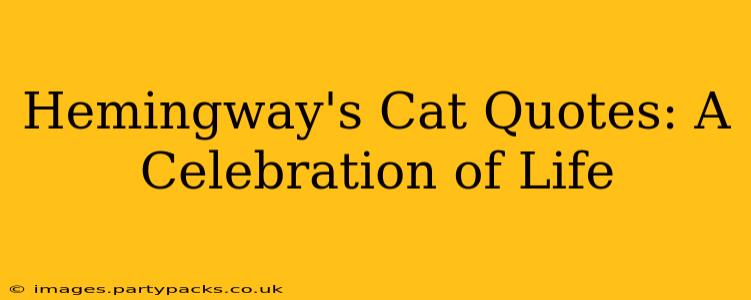Ernest Hemingway, the literary giant, wasn't just known for his powerful prose and adventurous life; he was also a passionate cat lover. His Key West home, now a museum, is still populated by his descendants, a colony of six-toed polydactyl cats. While Hemingway himself didn't pen many direct quotes about his cats, his life and writings offer glimpses into his feline companions and the unique bond he shared with them. This post explores the spirit of Hemingway's connection with cats, drawing from his life, his work, and the enduring legacy of his beloved polydactyls.
What Kind of Cats Did Hemingway Have?
Hemingway's cats weren't just ordinary house cats. He famously owned polydactyl cats, meaning they had more than the usual five toes on their paws. These cats, with their extra digits, are often referred to as "Hemingway cats." Their unique physical characteristic became a defining feature of the feline legacy associated with the author. The current colony at the Hemingway Home Museum in Key West is a direct descendant of these original polydactyl cats.
Why Did Hemingway Love Polydactyl Cats?
The exact reason behind Hemingway's fondness for polydactyl cats isn't explicitly documented. However, it's likely a combination of factors contributed to his preference. The cats’ unusual appearance certainly made them stand out, aligning with Hemingway's own penchant for the unique and unconventional. Beyond the aesthetics, it's plausible he appreciated their robust nature and independent spirit, qualities that mirrored his own personality.
What are Some Famous Quotes About Cats from Ernest Hemingway's Writings?
While there aren't direct quotes explicitly about his own cats, Hemingway's writing often features cats as symbolic creatures, reflecting various themes in his work. For instance, cats' independence and resilience are often reflected in his characters. His descriptions of nature often weave in observant descriptions of cats and other animals, highlighting his appreciation of the natural world and the independent lives creatures lead within it. While not direct "cat quotes," the underlying themes present in his work showcase a profound understanding and respect for the animal kingdom.
Did Hemingway Write About Cats in His Stories?
Hemingway's cats weren't directly featured in prominent roles in his novels or short stories in a literal sense. However, the spirit of his feline companions, their independence, and their quiet strength, often permeates the unspoken and subtextual elements of his works, enriching the character development and settings. The underlying essence of his cat’s nature indirectly informs his literary creations.
What is the Legacy of Hemingway's Cats?
The legacy of Hemingway's cats is profound and continues to this day. The colony at the Hemingway Home Museum in Key West, descended from his original polydactyls, serves as a living testament to his love for these unique animals. Visitors from around the world come to see these cats, keeping the spirit of Hemingway's feline companions alive and reminding us of the enduring bond between humans and animals. Their presence ensures that Hemingway's love for his cats transcends time. They're a unique attraction, a living embodiment of a part of Hemingway's life that many find fascinating.
Are Hemingway Cats a Specific Breed?
No, "Hemingway cat" isn't a breed designation. It's a colloquial term referring to polydactyl cats, specifically those descended from Hemingway's original cats or sharing their six-toed trait. Polydactyly is a genetic trait that can appear in various cat breeds.
This exploration showcases that while we may not have direct quotes from Hemingway himself gushing over his cats, the undeniable connection between the author and his feline companions lives on, enriching his legacy and inspiring cat lovers worldwide. The Hemingway cats, with their unique charm and historical significance, represent a fascinating chapter in the life of a literary icon.

